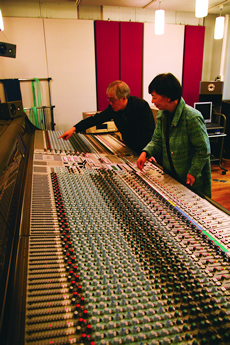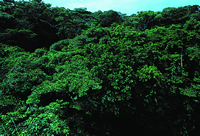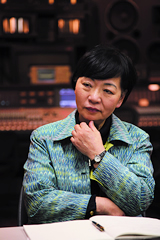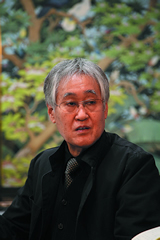| Biohistory journal, Summer, 2006: Index > The whole body senses sound |
| Searching for interrelationships with sound
The whole body senses sound |
|
|
|
Once, in the studio, I amplified a high-frequency sound exceeding 20 kHz, inaudible to the human ear. When I raised the pitch, I discovered that the resulting sound had a bewitching quality that was quite appealing. Our heretical sound is just the thing for music.
|
The studio integrates a picture of a forest rendered by a Balinese painter, and a huge broadcast device that looks like a photograph. The designer was British, and it is impressive because the shape, color, and materials are beautiful. This verifies that the sound inaudible the human ear is producing a “good sound”. The awareness and method of using science to the fullest to critique the modern civilization of science and technology with the end of eventually transcending science is identical to that of the Biohistory Journal. The presence of a person of one’s own generation who has thought with his body is deeply impressive. I got a true sense of the importance of a person who has integrated science and the arts within his own body, but who says that one shouldn’t talk of a fusion between the two. Before I knew it, I had asked for a jacket made in Bali. (Keiko Nakamura)
|
Nakamura: Ohashi:
Nakamura:
Ohashi:
Nakamura:
|
Tsutomu Ohashi Born in 1933, Ohashi graduated from Tohoku University with a degree in agriculture. After working at the University of Tsukuba and MEXT’s National Institute of Multimedia Education, he served as a director and chief researcher at the Foundation for the Advancement of International Science. Ohashi is a proponent of information environment studies. He discovered the hypersonic effect, in which sound that incorporates high frequencies beyond the range of human hearing is used to activate the brain. He is also a musician working under the stage name of Shoji Yamashiro, and is the leader of the Geino Yamashiro Gumi. His primary books are “Information Environment Studies” and “Sound and Culture”. He also has recorded the albums Ecophony Rinne and Symphonic Suite Akira. |
After the dialogue / Tsutomu Ohashi I was pleasantly reminded that when I first saw Ms. Nakamura, I spent days on end, from morning to night, discussing the Tsukuba Expo ’85 theme of “Dwellings and Surroundings: Science and Technology for Man at Home”. It’s a paradox, but the most important weapon for confronting the crisis created by modern science and technology is actually none other than modern science and technology. It’s our good fortune that the wisdom to overcome the limits of modern science and technology, primarily fostered by Western civilization, exists in great density as implicit knowledge and traditional knowledge in the sphere of non-Western civilization, including Japan. Research into the hypersonic effect that we discussed in the Dialogue (the effect in which sound with a significant concentration of high frequency elements above the range of human hearing elicits positive physiology, psychology, and activities by activating the core portion of the brain) has truly grown from a seed sown at that time. Though it had been a while since we talked, it did not feel as if an interval of time had separated us. There was an amazing feeling of two like-minded people being connected from that time. In that period, Ms. Nakamura has viewed life with a penetrating gaze and consistently high ideals. It was a pleasant and enjoyable time, and I was inspired by her unchanging vivacity of thought and sensibility. |
| Dialogue |
Please close a window with the button of a browser who are turning off Javascript. |



